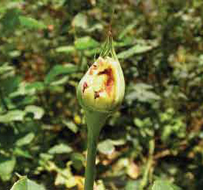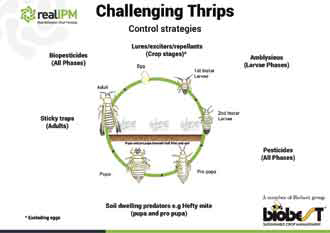Thrips represent probably the number one pest in ornamentals, not only in Kenya but also globally. If we were to ask a Kenya rose grower what was number one pest, ten – fifteen years ago this would have been definitely red spider mite. However, spider mite control has moved on. Now we have predatory mites Phytoseiulus persimilis and Amblysieus californicus, we have biopesticides like Achieve and finally we have the organosilicon physical action sprays. These products have transformed the control of spider mite in Kenya. So where are we with thrips and why is this pest seemingly such an intractable problem.
By Henry Wainwright
 Identification and damage
Identification and damage
The thrips we mostly get in ornamentals in Kenya are the Western Flower Thrips (WFT), Frankliniellaoccidentalis. The adults of thrips are easy to see, as they are small, slender insects and wings tightly tucked into their bodies. For the larvae they are more difficult to spot as they are lighter in colour (translucent yellowish), smaller and usually hide in small crevices of the plant. The larvae do not have wings and so cannot fly. The damage is caused by the thrips feeding on the soft plant tissue like flower petals or young green tissue. Older leaves are rarely attacked by thrips. The adult puncture the outer layer of the plant tissue (epidermal layer) and suck the cell contents out of the leaf cells. This can lead to discolouration and flecking and cell necrosis (death). In addition this dead cell becomes susceptible to secondary infect of botrytis. Therefore increased thrips damage is often associated with increase flower head botrytis. For the larvae damage have more of a scratching appearance as they move in small lines rather than the single point damage of an adult. Regardless of whether damage is caused by an adults or larvae of a thrip, the consequence is a rejected flower if damage has occurred.
Life Cycle
The success of thrips as a pest is due to many features but one of the most important survival strategies is through its life cycle. As shown in the diagram, thrips both exist on the plant, in the air and finally in

the soil. The eggs are laid on young leaves, buds and petals often in crevices and cracks. The eggs hatch and the larvae can immediately begin to feed and cause damage. There are two larvae stages before the non-feeding stage (pre-pupa and pupa) develop and drop to the ground. From the pupa the adult emerges and flies off looking for new egg laying sites. This means that efforts to control the thrips have to look at all the different stages of the life cycle. This is further complicated because there is no one single control method that works for all stages.
Unlike Phytoseiulus for spider mite control, as this predator can control all stages (eggs through to adults) but this is not the case with thrips. Other characteristics that make thrips a successful pest include The thrip is described as having a cryptic and thigmotactic behaviour, which means it likes hiding. This reduces the likelihood of getting contact insecticides to control the pest. The thrips have fast reproduction cycle taking no more than 7 days at 250C to complete the life cycle. This is one reason why pesticide resistance develops quickly. The development of resistance in thrips to many pesticides has been a major contribution to why thips have become increasing difficult to control with conventional pesticides. Resistance can also develop where growers overuse single active ingredients/mode of actions such as spinosad or neonicotinoid containing pesticides.
Another important question is, where do the thrips come from? This has long been an issue that is not yet fully answered. Either the adults emerge from the pupa in the greenhouse soil or they arrive from outside. Thrips are essentially weak fliers and come in the direction of the wind. This can cause the numbers to dramatically increase in a short time if they migrate from outside, such as cereal are being harvested in the locality. The cereal thrips though they can feed on crops like roses they do not establish and breed in a rose crop. However, we also get WFT located in hot spots in a greenhouse and these hot spot are hard to eliminate. This suggests that these are “homegrown” thrips originating from the soil in that area of the greenhouse. Increasingly we see this permanent present of thrips in crops as a new development and hard to eliminate.
Managing thrips
There is no silver bullet or single effective control measure. What is required is an integrated approach using the many weapons that have been developed. Because of the complex life cycle there are separate strategies of each life cycle stage as illustrated in the diagram. These include:
Monitoring
The rapid and accurate detection of thrips level is the first basic step in controlling thrips. This can involve tapping the flowers onto white paper and counting the thrips, simple visual inspection or using sticky traps as monitoring devices. The easiest stage to monitor is the adult but thrips larvae can also be assessed but they are more difficult to detect. The historical assessment of trends is also of practical help as this allows the grower to assess trends and the effectiveness of controls. Tools such as Scarab scouting offer more sophistication and easier quantification to enable informed crop protection decisions. When monitoring thrips the scout must appreciate that, the thrip behaviour changes during the day so it is always best to scout at the same time every day to enable accurate comparison of different day’s data. Also in the middle of the day chances of seeing and recording thrips is lowest.
Adult control.
Pesticides have been the primary method of controlling adults through contact and systemic activity. However, with the increase in pesticide resistance and the pressure of consumer to reduce pesticide other methods of control will be required. Mass trapping, through the use of sticky traps has been increasingly adopted, primarily blue but yellow has been shown to very similar in thrip catches. The thrips that migrate into greenhouses then barriers, such as thrip proof netting has been shown effective and has been widely adopted in the cutting industry. The use of netting for rose growers is under review by many growers; however, the challenge is that the netting changes the environment (humidity and temperature) which might bring other problems such as diseases.
Larvae control.
One of the most successful methods of control that has been adopted in recent years has been the use of predatory mites. The most established predatory mite has been Amblyseius cucumeris. Though it does not breed in the rose crop, the cost is relatively low, so they can be introduced regularly as a prophylactic control. More recently, we have seen the adoption of Amblyseius mondorensis. This is a useful mite as it not only feeds on both stages of larvae (which cucumeris does not), but it will also eat spider mite. Interestingly Monty is being adopted world-wide as a thrips larvae solution.
Pupa control.
The pupa and pre-pupa stages in the soil are often been neglected in the control strategy of growers. Their management will not assist those thrips that migrate into the greenhouse from outside but for the home grown thrips and hot spots their management is essential. Predatory soil mites such as Hypoaspissclerotarsa have been shown to be effective in reducing thrips damage when applied to the soil on monthly intervals. A benefit of H.sclerotarsa has been that it has reduced the level of mealybug in the soil, which are often a source of infection to young rose crops.
Cultural control.
Western Flower Thrips have many alternative hosts. It is always good to check the plants surrounding the greenhouse to assess whether they are harbouring thrips that will migrate into the greenhouse. Sometimes these are not always possible to eliminate such as near-by coffee or cereals but flowering plants of different sorts can be managed. Discarded flower heads also contain thrips so removal and disposal of rejected flowers heads well away from the greenhouse are important. The use of mulches under rose crops has recently shown to reduce thrips emerging from the soil pupa. They give rise to a drier crop and can reduce diseases but can increase the spider mite pressure due to the lower humidity in the crop. Finally, there are big differences in the susceptibility of different roses varieties to thrips attack. Knowledge and the ability to anticipate thrip problems is an tool for the grower.
Better spraying.
Pesticides and biopesticides such as Campaign (Metarhizium) and Prevail (Beauveria) are applied trough conventional spraying programmes. However there is also need to ensure that their spay application is optimised. Calibration and sprayer maintenance are key. Additional growers have looked to attractants and exiters to lure the thrips adults and larvae out of hiding. This has involved mixing with the sprays sugars or molasses. More recently the incorporation of exciters such as Pullit into the spray tank, based on flower volatiles, excites the trhips and pulls them out of hiding so they are more exposed to the controlling spray.
Going forward thrips management will be of increasing concern to the Kenyan rose grower. It is number one pest and the control strategies are complex and difficult to manage. At Real IPM we have prioritised this as the pest requiring the most development in terms of new solutions. The crop protection tools available to the grower are increasing every day, however there is no silver bullet. From Page 39


